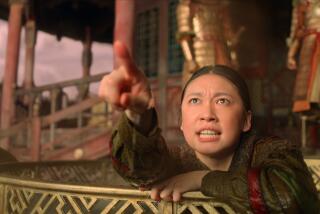Book review: ‘A Dance With Dragons’ by George R.R. Martin
George R.R. Martin’s “A Dance With Dragons,” the fifth book in the hugely popular Song of Ice and Fire fantasy series, is one of the most anticipated novel of the last few years. In the four previous volumes of this sprawling fantasy epic, which was inspired by England’s War of the Roses in the 1400s, Martin has captivated readers with complex story lines, fascinating characters, great dialogue, perfect pacing, and the willingness to kill off even his major characters. His readers now number in the millions and a recent HBO series — “Game of Thrones” — based on the first installment in the series faithfully showcases all of Martin’s strengths.
Was “A Dance With Dragons” worth the six-year wait? Absolutely. Indeed, Martin’s decision to release a sizable chunk of his story-in-progress as the fourth installment — the underrated “A Feast for Crows” (2005) — now seems wise and actually generous to readers. Originally intended for release as one novel, “Feast” and “Dance” overlap in terms of the time period covered, but they are vastly different. “Feast” chronicled aftermath, the dying fall after the great battle that ended the third book, “A Storm of Swords.” But “A Dance With Dragons,” which overtakes “Feast” chronologically after about 600 of its 1,000 pages, functions more as a novel about exploration and quests.
Several narrative threads in “Dance” document the attempts of suitors to reach the city of Mereen. They hope to vie for the hand of the dragon queen Daenerys Targaryen, heir to the Iron Throne, the seat of power on the continent of Westeros. A quest of sorts also accretes around the popular character Tyrion Lannister, whose absence from “Feast” irked some readers. Exiled from his homelands for a grievous crime, Tyrion is in fine form in “Dance,” witty, devious, smart, and getting into all sorts of trouble. Other favorites from the first three books also return, including Bran Stark, the clairvoyant boy called to the north of Westeros by a three-eyed crow from a vision.
Martin’s love for sophisticated, deeply strange fantasy permeates “Dance” like a phantasmagorical fever dream. Bran’s arrival at the crow’s sanctuary contains some of the wildest, most beautifully alien scenes in the series. Even Tyrion’s journey in a boat sailing down a haunted river, replete with ghost boats and thick fog, provides thrills for jaded readers: “The drowned city was all around them. A half-seen shape flapped by overhead, pale leathery wings beating at the fog.”) Martin’s brilliance in evoking atmosphere through description is an enduring hallmark of his fiction, the settings much more than just props on a painted stage.
But perhaps most impressive is Martin’s understanding of how powerful people often rule under ever-increasing constraints, exemplified by Daenerys and Jon Snow, commander of Westeros’ northern Wall. Jon’s forces are the only defense against strange undead creatures headed south during the approaching winter. To fulfill his sworn duty to the Wall, Jon must resist the demands of an army come to the wall’s defense and ignore his birthright as heir to a kingdom. Daenerys, meanwhile, rules an occupied city whose elites oppose her decision to free their slaves. Her dragons, the main source of her power, have grown less and less obedient. Every decision she makes seems to take her further from her goal of reclaiming the Iron Throne. On some level, Jon and Daenerys are trapped and must ask themselves difficult questions. What is the nature of duty? Which sacrifices support a greater good and which do not? When is an act of mercy actually an act of cruelty? By novel’s end, Jon and Daenerys arrive at similar answers but vastly different destinies. Daenerys’ fate in particular yields one of the most powerful scenes in the entire series.
Some reviewers have compared Martin’s work to that of J.R.R. Tolkien or even William Shakespeare, but the truth is a little more complex. The Song of Ice and Fire novels work so well because the epic fantasy is grounded in a strong horror element and because Martin skillfully conveys the gritty (often bawdy) physicality of the world while moving, with equal effectiveness, between various levels of society. Martin also owes a debt to the dark yet humane cynicism of writers like Jack Vance, even though he cares much more about the inner life of his characters than Vance. Martin’s devotion to fully inhabiting his characters, for better or worse, creates the unstoppable momentum in his novels and contains an implied criticism of Tolkien’s moral simplicity.
Having overcome the writerly challenges of a series grown longer than expected — and having survived the well-documented hostility of those readers who have displayed a grotesque sense of entitlement over publication delays — Martin seems poised in the last two books to bring home one of the best series in the history of fantasy.
VanderMeer’s latest books are “The Steampunk Bible” (Abrams) and the anthology “The Thackery T. Lambshead Cabinet of Curiosities” (HarperCollins). He lives in Tallahassee, Fla.
More to Read
Sign up for our Book Club newsletter
Get the latest news, events and more from the Los Angeles Times Book Club, and help us get L.A. reading and talking.
You may occasionally receive promotional content from the Los Angeles Times.






